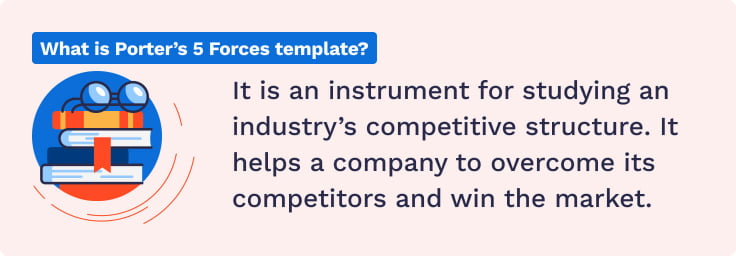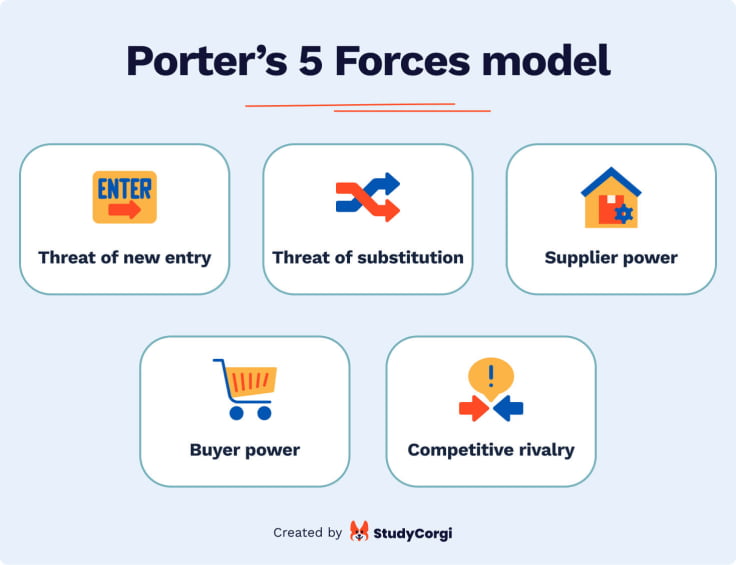👍 Porter's Five Forces Generator: the Benefits
Here are the key benefits of this Porter’s 5 forces template
| 😎 User-friendly | All you need to do is follow the prompts. |
|---|---|
| 🦋 Tunable | Choose the Porter’s 5 forces template you like most. |
| 🌐 Online | There is no need to download any software. |
| 🆓 No payments | 100% free, with no sign-ups or hidden payments. |
📌 Porter’s Five Forces Template: How Does It Work?
- Take your time to fill in the blanks with data on each parameter.
- Add extra fields where necessary.
- Apply the Porter’s five forces template you like and check the example generator.
- Press the colored circle in the left lower corner to choose the color scheme.
- Select the file extension.
- Download the result free of charge.
💸 Porter’s 5 Forces Model Explained
Porter’s Five Forces template is an instrument for studying an industry’s competitive structure.

The information obtained through the diagram helps to develop the right corporate strategy to overcome the competitors and win the market.
The five forces comprise the following aspects.
Threat of New Entry
A low cost for a competitor to enter the market and become an effective competitor weakens the position of established companies.
- How much time and money does it take to enter the market?
- Is specialist knowledge required for this purpose?
- Are there any economies of scale?
- Are there any cost advantages?
- How hard is it to obtain the technology?
- What are the barriers to entry?

Threat of Substitution
Companies producing goods or services with no close substitutes have the power to raise prices and lock them in favorable terms. Meanwhile, comparable alternatives give the clients a choice to go to another company, weakening the power of both.
- How much does it cost to change the product so that it has fewer substitutes?
- How good are the available close alternatives?
Supplier Power
Few industry suppliers make the existing companies depend on them. Meanwhile, numerous suppliers and low switching costs raise the companies’ profits.
- How many suppliers are there?
- What is their scale?
- Do they provide unique services or raw materials?
- Can the company substitute the supplier’s role?
- How much does it cost to switch between the suppliers?
Buyer Power
A high number of clients gives them the power to negotiate lower prices.
- How many clients are there in the market?
- How big is the average order?
- How sensitive are the clients to prices?
- Can the clients find a substitute, and will the change cost them anything?
Competitive Rivalry
A large number of competitors or equivalent products in the market decrease the power of each company entering or existing in it.
- How many competitors does the market have?
- What are the quality differences?
- How costly is it to switch production within the market?
- How loyal are the typical customers?
- How much does it cost to exit the market?
🆚 Porter’s 5 Forces Template vs. SWOT
Although both models are excellent analytical tools for strategic planning, they differ. A Competitive Forces Model analyzes the competitive environment within the market or industry, while a SWOT analysis looks deeper into the company to evaluate its internal potential.
❌ Porter’s Five Forces Model: The Limitations
| It is static | The model provides a picture of an industry at some moment in the past. The factors can dramatically evolve even while you are writing the conclusions. Still, when Porter invented the framework, technological advancements weren’t as prominent as they are now. |
|---|---|
| It overlooks globalization | More often than not, a competitive environment is not limited by country borders, thanks to the advances in logistics. But calculating the worldwide market in terms of Porter’s model would be cumbersome. |
| It is used for unintended purposes | The most common mistake is applying the model to a specific company rather than the industry where it functions. The picture produced through such an incorrect analysis can be distorted and misleading. |
| It requires drawing clear industry limits | Today it is almost impossible to define where one industry ends, and another starts. The unevenly globalized world aggravates the task even further. |
| It gives freedom to ignore the alternatives | The model is not sufficiently precise, as you can merely overlook some factors that don’t fit in the long-standing industry patterns. It makes the results questionable and hardly reliable. |
📄 Porter’s Five Forces Analysis Examples
Below you’ll find a collection of Porter’s Five Forces essay examples that focus on various industries. We hope that you’ll get inspired by the list below.
-
Porter’s Five Forces and Its Business Application
The paper focuses on how the Porter’s model is applied to strategic business analysis.
-
Porter’s Five Forces Model: JW Anderson
The essay analyzes the brands created by Jonathan Anderson using the Porter’s model.
-
Zicklin School of Business’s Porter’s Five Forces Analysis
The paper discusses the competitive advantages of one of the three biggest US schools.
-
Texas Roadhouse Inc.’s Porter’s Five Forces
The essay looks at the competitive environment in which Texas Roadhouse, Inc. Operates.
-
Walmart: Porter’s Five Forces Analysis
Using Porter’s framework, the paper reveals why the company is on top of retail industry.
-
Movie Theatre Business: Porter’s Five Forces Analysis
The paper analyzes the industry of movie theatres using five forces model.
-
Japanese Animation Industry and Porter’s Five Forces
The essay focuses on the economic factors that influence animation industry in Japan.
-
Five Forces Model: Beer Industry Analysis [Porter’s Model]
The sample studies beer industry using the Porter’s competitive forces model.
Thank you for reading this article! If you are interested in other business analysis options, consider trying our SOAR, VRIO, and PESTEL analysis makers.
❓ Porter’s Five Forces Template FAQ
❓ What Is the 5 Forces Model?
The Five Forces Model is a guideline to assess the competitive environment that exists in the industry at a specific moment in time. It allows for predicting the outcome of entering the market for new players and is a powerful strategic tool.
❓ What Is Porters 5 Forces Model Used to Assess?
The model assesses the attractiveness of a market for new players. It also evaluates the chances of raising the profitability of existing companies. This information is gained through analyzing the five competitive forces.
❓ How Do Companies Use Porter’s 5 Forces Model?
Companies use Porter’s Five Forces Model to:
- Assess the power of existing competitors;
- Adjust the competitive strategy accordingly to the current market situation;
- Explore the opportunities of introducing new products;
- Assess the rationality of investment opportunities.
❓ Why the 5 Forces Model Is Limited?
- It can provide reliable results only from the short-term perspective;
- It allows you to overlook the alternatives;
- It ignores the blurred industry limits;
- It does not consider the rapid pace of globalization;
- It cannot be applied to individual companies.